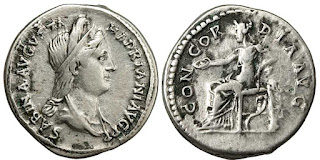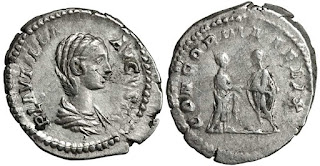Zoroastrianism is an Iranian religion and is one of the world's oldest organized faiths, based on the teachings of the Avesta and the prophet Zoroaster. In Zoroastrianism, the fire altar or fire temple (agiyari) is an important symbol. It represents the enduring energy of the creator and is the focus (not the object) of the prayer. Achaemenes founded the first Persian empire around 700 BC. Zoroaster probably lived about 100 years later.
Sasanian Empire, Drachm, Khusro I, 531-579 AD, Fire Altar
Zoroastrian religion enters recorded history around the middle of the 6th century BC. For more than a millennium, between 600 BC and 650 AD, it served as the official religion of the ancient Iranian empires, beginning around the Achaemenid Empire, that was captured by Alexander and his successor Seleucus I Nicator founded the Seleucid dynasty around 300 BC. However, this was captured by the Parthians, who used the same Pahavi script. and claimed to be ascendents of the Achaemenids. The kingdom formally came to an end with the Muslim conquest of Persia. The fall of the Sasanian Empire and the persecution of Zoroastrians by the early Muslims culminated in the decline of the religion. Many Zoroastrians fled to the Indian subcontinent, where they were granted refuge by various kings. The majority today reside in India, Iran and North America.
The Fire Altar and Persia.
The kings of Persis are not well known, and nor is the order of succession. Their names appear quite differently depending on whether it is read in Greek or Persian. Often the two are equally valid as the Persian ruling class was Greek in origin during the Alexander and Seleucid period.
Hemi drachm of Darev II of Persis, 100 BC, silver, weight 2.2 gm, Obverse: Bust of bearded king left wearing Parthian style tiara ornamented with crescent and diadem, Reverse: King holding scepter over fire altar. The script is Aramaic.
Hemi drachm of Artaxerxes or Ardaser II of Persia, 50-1 BC, silver, weight 2.0 gm, Obverse: Bust of bearded king left wearing mural crown with battlements, Reverse: King standing left, holding scepter before lighted altar, Aramaic legend.
The Sassanian Empire.
The last king of Persis, Ardeshir revolted successfully against the Parthians and established the Sasanian empire, becoming Ardashir I. The name ''Sassanid'' or ''Sassanid'' was invented by later historians, based on the name of Ardashir's parental grandfather Sasan. Sasanian coins were distinctive, showing the royal hair dress on one side and a fire altar with attendants on the other side.
Silver Drachm of Sassanid Shapur 241-272 AD, weight 4.4 gm, Obverse: Bearded bust of Shapur I, right, wearing merlon crown with ear flaps and surmounted by globe, legend translated as ''The Mazdah'' worshipper, the divine Shapur, King of the Kings of Iran, heaven descended of the Gods, Reverse: Fire altar with two attendants dressed in kingly garb, facing outward, spear in outer hand, legend translated as ''The fire of Shapur''.
Silver Drachm of the Sassanid Shapur 309-379 AD, weight 3.9 gm, Obverse: Bearded bust of Shapur II, right wearing merlon crown surmounted by globe decorated with three lines and pellets, diadem ties behind crown, Reverse: Fire altar with two attendants dressed in kingly garb, facing inwards, short staff in both hands, bust of Ahuramazda right in flames above altar, Pahlavi script on altar.
200 years after the last coin, the altar and attendants are becoming more stylized, and the king's portrait is also somewhat less realistic. The coins are thinner and have a wide rim which is less regular in outline. These were thin flan coins.
Silver Drachm of the Sassanid Khusro 579 AD, weight 4.0 gm, Obverse: Facing bust head right wearing merlon crown with tassel to left and surmounted by crescent with three flames, inside single dotted border, crescents at 3, 6 and 9 o'clock, Reverse: Fire altar with two attendants standing facing wearing headgear, both hands on sword hilt, all inside single dotted border.
Kushan Shahs.
The Sassanid empire was large and powerful, and exercised its control through vassal states in Bactria and Gandhara, often referred to as Kushan Shahs. They were allowed their own coinage under Sassanid patronage. The coin below comes from Bactria, a mountainous area to the west of Gandhara, which now forms part of several countries, including Afghanistan, Turkmenistan and Uzbekistan, but mostly Tajikistan. It was struck for Peroz II.
Bronze Drachm of Peroz II, 300-325 BC, weight 2.0 gm, Obverse: Pahlavi legend, bearded bust right wearing horned headdress, long ribbons flow upwards from the hair, behind, Reverse: Pahlavi legend. Fire altar with God arising from it, holding filleted diadem and scepter.
Nezak Huns
This interesting and elaborate design of the coin shown below, is minted in Kabul. It shows the king wearing a buffalo's head over a winged helm. The makers of these coins are referred to as Hunas, Indo-Hephthalites, Turco-Hephthalites, Nezak Huns or sometimes White Huns.
Billon Drachm, Nezak Malkas, 630-711 AD, weight 3.3 gm, Obverse: Pahlavi legend Nycky MLK, bust right wearing winged Buffalo crown, Reverse: Fire altar with attendants, wheel above each, control marks at left and right.
Kashmir Smast
In Gandhara, now north of Pakistan, is the Kashmir Smast, a network of caves which formed the center of an independent kingdom in the 4th to 8th centuries AD. Many coins have been found here. These caves have not yet been fully explored.
Bronze quarter drachm from Kashmir Smast, 7th-8th century AD, weight 1 gm, Obverse: Nezas style bust right, wearing Hephthalite trident crown, military standard before face, Pahlavi letter and tamgha behind head, Reverse: Fire altar with attendants' wheel above each.
Turco-Hephthalite Countermarks
Some of the Sassanid coins were re-used by the Turco-Hephthalites. The Sassanid ruler Khusro II was very expansionist. He re-conquered most of the territory of the old Achaemenid empire. However, he was assassinated in 628 AD, and the empire never recovered. Coins of Khusro are easy to find, but the coin shown below is less common. It has a counter mark showing it was given the approval to be used as a currency.
Silver drachm of the Sassanid Khusro, 591-628 AD, with Turco-Hephthalite countermark dated 650-700 AD, weight 3.8 gm, Obverse: Facing bust, head right, wearing winged crown with star and crescent inside double dotted border, crescents with stars at 3,6 and 9 o'clock, Reverse: Fire altar with two attendants standing facing, both hands on sword hilt, crescents on heads, all inside triple dotted border, crescents with stars at 3, 6 and 9 o'clock.
Umayyad Caliphate.
The Sassanian empire fell to the Caliph Umar in the mid 7th century AD. The Zoroastrians were eventually accepted as ''People of the Book" and a policy of tolerance was applied. Though, inevitably, within a couple of centuries most Persians became Islamic. Tabaristan, now the province of Mazandaran in North Iran, remained independent of the Umayyads, and the mountain regions were independent for some while. But late, their successors, the Abbasid Caliphate controlled some areas. Here, below is a coin of an Abbasid Caliphate governor, Saíd bin Da'laj, struck by the Tabaristan mint.
Silver Hemi drachm of Said bin Dalaj, Tabaristan, 772-779 AD, weight 1.9 gm, Obverse: Crowned bust right, Reverse: Fire altar with attendants.
Bukhara in Sogdiana, currently Uzbekistan
Sogdiana was rich in Persian cultural history, having been a province of Achaemenid Persia, and so the Tamgha chosen for the coins was a fire altar.
Bronze Abbasid Fals of Bukhara, 766 AD, weight 1.8 gm, Obverse: Horizontal Arabic script inside dotted circle, fire and altar tamgha below, script around the outside of the circle, Reverse: Horizontal Arabic script inside dotted circle. Star below, script around the outside of that circle.
Fire Altars in India
When the Umayyad Caliphate conquered Persia, many Zoroastrians fled, migrating to India and mostly reaching Gujarat. The coin below comes from Rajasthan, depicts a Sassanian style fire altar with attendants,
Silver drachm, Pratiharas, 780-980 AD, weight 3.6 gm, Obverse: Sassanian style bust, Reverse: Fire altar with two attendants.
The Buddhist Pala dynasty ruled Bengal in the 9th century. The coin below is much more stylized, and the design was much larger than the flan of the coin. The reverse is the left side of the fire altar, with one dot of flame visible.
Silver drachm Pala ruler, 853 AD, weight 4.0 gm, Obverse: stylized Sassanian bust, Reverse: Fire Altar.
The coin below is of the Saindhava dynasty, who were eventually conquered in 915 AD by the Abhiras dynasty, who owed their allegiance to the Pratiharas. The bust and fire altar are crudely done but styled differently.
Silver drachm Saindhava, ruler of Saurashtra, 800-950 AD, weight 4.1 gm, Obverse: Stylized Sassanian style bust, Reverse: Fire altar, with part of an attendant visible to right.
The design of coins from Gujarat, below, is derived from the silver drachms of the Sassanian king Peroz, who's coins were brought to Northern India by the invading Huns in the 6th century AD.
Silver drachm (paisa, Gadhiya) of Chalukya of Gujarat, 900-950 AD, weight 4.1 gm, Circle lip type, Obverse: Stylized head of ruler, Reverse: Fire altar, sun (with rosette of dots) above left crescent moon above right.
The three-dimensional coin shown below, is much different from the flat thin Sassanian drachms. The design is so stylized here that one doesn't recognize the head and fire altar motifs. But the coin type over several hundred years remained consistent.
Bronze Drachm of Vaghela of Gujarat, 1210-1300 AD, weight 4.6 gm, Obverse: Stylized head of ruler Reverse: Fire altar.
The coin below, shows the purity of the design making way for something more informative. The curves to the left of the head are a Brahmi ''Ja'' symbol. To the right of the head, is an inverted triangle and another sun and moon symbol. The shaft of the fire altar on the reverse has ''Sri Omkara'' written on it, which indicates that it was minted at the Omkara Mandhata Monastery in Malwa.
Silver drachm of Paramaras of Malwa, 1150-1300 AD, weight 4.1 gm, Obverse: Degenerated Indo-Sasanian style bust, inverted triangle topped by sun and moon to right Brahmi letter ''ja'' in left field, Reverse: Crude fire altar with the legend Sri Omkara on shaft.

















































